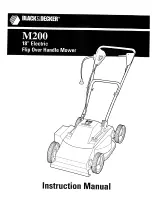
Section 1: Assembly & Set-Up Important Safety Information
FDR1648, FDR1660 & FDR1672 Rear Discharge Grooming Mowers 310-366M
12/2/21
14
Upper 3-Point Hitch Assembly
Refer to Figure 1-2 on page 15:
1. Remove angle shipping brackets (not shown) with
gauge wheel assemblies (#4) from mower frame.
2. Remove rear hitch braces (#1), A-Frame hitch braces
(#2), and clevis hitches (#3) from shipping crate.
3. Attach rear hitch braces (#1) to hole “A1” inside of
rear hitch mounting plates (#5) with 5/8" bolts and
flanged locknuts (#6) provided in rear hitch plates.
Do not tighten nuts.
4. Attach A-Frame hitch braces (#2) to holes “A2” inside
front hitch mounting plates (#7) with 5/8" bolts (#8)
and hex flanged locknuts (#8) shipped holding rear
hitch braces (#1) together. Do not tighten nuts.
5. Remove 5/8" x 5 1/2" lg. bolt, lock washer, and
nut (#11) from upper pivoting hitch (#9). Don’t let
spacer tube (#10) fall from upper pivoting hitch.
6. Swing A-frame hitch braces (#2) up to a vertical
position. Raise rear hitch braces (#1) up and outside
of A-Frame hitch braces as shown.
7.
Position upper pivoting hitch (#9) with hook (#20)
hanging down as shown. Assemble upper pivoting
hitch (#9) and spacer tube (#10) in-between A-frame
hitch braces (#2) with existing bolt, lock washer, and
hex nut (#11).
8. Tighten 5/8"-18 GR5 bolt (#11) to the correct torque.
9. Tighten 5/8"-11 GR8 bolts (#6 & #8) to the correct
torque.
Gauge Wheel Assembly
Refer to Figure 1-2:
1. Remove factory bolts from top of gauge wheel
spindles (#4).
2. Remove gauge wheels (#4) from angle shipping
brackets. Keep spacers (#12 & #13) with their
respective gauge wheels. Discard shipping brackets.
3. Insert gauge wheel yoke spindles (#4) into gauge
wheel arms (#14) with three 1" spacers (#12) below
each arm. Install remaining spacers (#12 & #13)
above each arm.
4. Remove linchpins (#21) from clevis hitch pin (#1).
Secure gauge wheels (#4) to gauge wheel
arms (#14) with linchpins (#21).
Lower 3-Point Clevis Hitch Assembly
Refer to Figure 1-2:
1. Attach lower right-hand clevis hitch (#3) outside of
right-hand mounting plate (#7) as follows:
a. Insert 5/8" x 1 3/4" bolt (#15), through SAE
standard washer (#17), clevis hitch hole “A”, hitch
plate (#7), and SAE standard washer (#17).
b. Secure bolt (#15) with hex top locknut (#19). Draw
hex top locknut (#19) up snug and then back off
1/2 turn to allow clevis hitch (#3) to pivot.
c. Insert 5/8" x 1 3/4" bolts (#16) through SAE
standard washers (#17), clevis hitch hole “B”, slot
in hitch plate (#7), and USS large washer (#18).
d. Secure bolt (#16) with hex top locknut (#19). Draw
hex top locknut (#19) up snug and then back off
1/2 turn to allow clevis hitch (#3) to pivot.
2. Repeat step 1 for the lower left-hand clevis hitch (#3).
Driveline Installation
Refer to Figure 1-3 on page 15:
1. To ease driveline removal, apply a liberal amount of
all purpose grease to the gearbox shaft (#4).
2. Pull back on the driveline pull collar (#2) and push the
yoke end with the long cone shield (#5) onto gearbox
shaft (#4). Release pull collar and continue to push
the driveline yoke forward until the pull collar pops
out and locks in place.
3. Support driveline (#1) as follows:
FDR1648
Rotate driveline support (#6) down and place
driveline (#1) in the support.
FDR1660 & FDR1672
Rotate driveline support (#3) down and place
driveline (#1) in the support.
NOTE:
The 3-point hitch system is designed for
front to back flotation when mowing on uneven
terrain. Additional field flotation and/or tractor
clearance can be obtained by mounting clevis
hitches (#3) in hole “B” or “C”. Rear brace
bars (#1) may need to be moved to holes “B2”.
IMPORTANT:
The driveline must be lubricated
















































